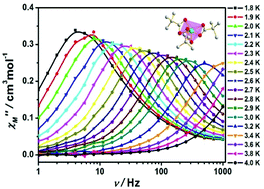Magnetic anisotropy and relaxation behavior of six-coordinate tris(pivalato)-Co(ii) and -Ni(ii) complexes†
Abstract
Experimental and theoretical studies of magnetic anisotropy and relaxation behavior of six-coordinate tris(pivalato)-Co(II) and -Ni(II) complexes (NBu4)[M(piv)3] (piv = pivalate, M = Co, 1; M = Ni, 2), with a coordination configuration at the intermediate between an octahedron and a trigonal prism, are reported. Direct current magnetic data and high-frequency and -field EPR spectra (HFEPR) of 1 have been modeled by a general Hamiltonian considering the first-order orbital angular momentum, while the spin Hamiltonian was used to interpret the data of 2. Both 1 and 2 show easy-axis magnetic anisotropies, which are further supported by ab initio calculations. Alternating current (ac) magnetic susceptibilities reveal slow magnetic relaxation at an applied dc field of 0.1 T in 1, which is characteristic of a field-induced single-ion magnet (SIM), but 2 does not exhibit single-ion magnetic properties at 1.8 K. Detailed analyses of relaxation times show a dominant contribution of a Raman process for spin relaxation in 1.



 Please wait while we load your content...
Please wait while we load your content...